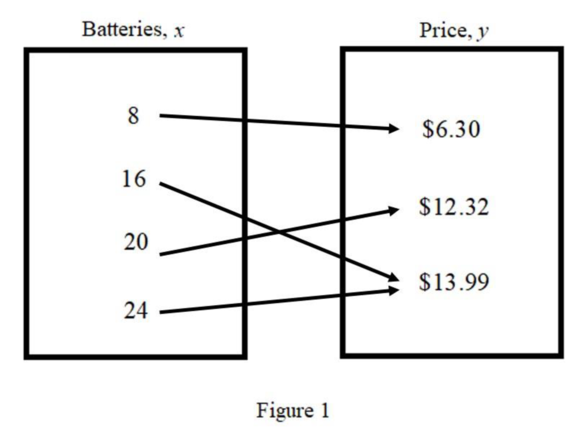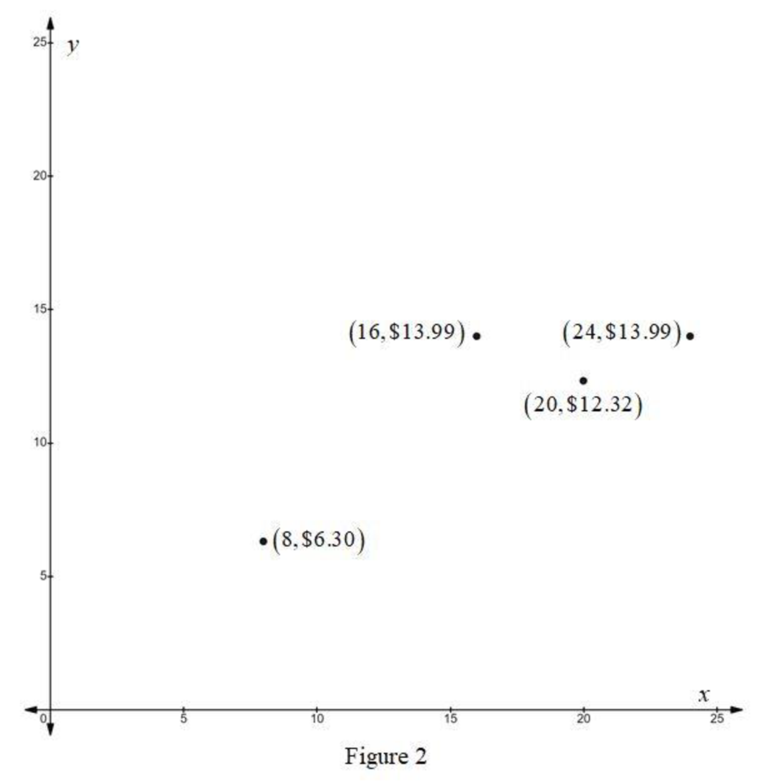
a.
The domain and the range of the relation between the number of AA batteries and the corresponding price.
a.
Answer to Problem 1RE
The domain and the range of the relation between the number of AA batteries and the corresponding price are
Explanation of Solution
Given:
The price of a pack of 8 batteries is $6.30.
The price of a pack of 16 batteries is $13.99.
The price of a pack of 20 batteries is $12.32.
The price of a pack of 24 batteries is $13.99.
Calculation:
The relation between the number of batteries and the price can be defined as 8 is mapped to $6.30, 16 is mapped to $13.99, 20 is mapped to $12.32 and 24 is mapped to $13.99.
The domain of the relation between the number of AA batteries and the corresponding price consists of different values of the number of batteries.
Hence, the domain of the given relation is
The range of the relation between the number of AA batteries and the corresponding price consists of different values of the price of batteries.
Hence, the range of the given relation is
b.
The relationship between the number of batteries and the corresponding price as a set of ordered pairs.
b.
Answer to Problem 1RE
The relationship between the number of batteries and the corresponding price expressed as a set of ordered pairs is
Explanation of Solution
Take the first coordinate as the number of batteries in a pack and the second coordinate as the corresponding price.
Obtain the relationship between the number of batteries and price as a set of ordered pairs as shown below.
Hence, the relationship between the number of batteries and the corresponding price expressed as a set of ordered pairs is
c.
The relationship between the number of batteries and the corresponding price as a mapping.
c.
Explanation of Solution
Use the variable x for the number of batteries and y for the price.
Take x values as the 8, 16, 20 and 24.
Take y values as $6.30, $12.32 and $13.99.
Obtain the relationship between the number of batteries and their price as a mapping as shown in Figure 1.

From Figure 1, it can be observed that a pack of 16 batteries and a pack of 24 batteries have the same price $13.99.
d.
The relationship between the number of batteries and the corresponding price as a graph.
d.
Explanation of Solution
Take the number of batteries along the x-axis and the corresponding price along the y-axis.
Plot the points

From Figure 2, it can be observed that a pack of 16 batteries and a pack of 24 batteries have the same price $13.99.
Want to see more full solutions like this?
Chapter 3 Solutions
Algebra And Trigonometry (11th Edition)
- > > > we are hiring Salesforce Admin Location: Remote Key Responsibilities: Administer Salesforce Sales & Revenue Cloud (CPQ & Billing) Configure workflows, validation rules & dashboards Automate processes using Flows & Process Builder Collaborate with Sales, Finance & Marketing teams Manage user roles & security Apply: Hr@forcecraver.comarrow_forwardAnswer this questionarrow_forward1. vector projection. Assume, ER1001 and you know the following: ||||=4, 7=-0.5.7. For each of the following, explicitly compute the value. འབ (a) (b) (c) (d) answer. Explicitly compute ||y7||. Explain your answer. Explicitly compute the cosine similarity of and y. Explain your Explicitly compute (x, y). Explain your answer. Find the projection of onto y and the projection of onto .arrow_forward
- 2. Answer the following questions using vectors u and v. --0-0-0 = find the the cosine similarity and the angle between u and v. འརྒྱ (a) (b) find the scalar projection of u onto v. (c) find the projection of u onto v. (d) (e) (f) find the scalar projection of onto u. find the projection of u onto u. find the projection of u onto and the projection of onto . (Hint: find the inner product and verify the orthogonality)arrow_forwardPlease type out answerarrow_forwardPlease type out answerarrow_forward
- Please type out answerarrow_forwardUsing f(x) = log x, what is the x-intercept of g(x) = log (x + 4)? Explain your reasoning. Please type out answerarrow_forwardThe function f(x) = log x is transformed to produce g(x) = log (x) – 3. Identify the type of transformation and describe the change. Please type out answerarrow_forward
- Each graph below is the graph of a system of three linear equations in three unknowns of the form Ax = b. Determine whether each system has a solution and, if it does, the number of free variables. A. O free variables ✓ B. no solution C. no solution D. no solution E. 1 free variable F. 1 free variablearrow_forwardSolve the following systems of equations and show all work.y = x2 + 3y = x + 5 Please type out answerarrow_forwardSolve the following system of equations. Show all work and solutions.y = 2x2 + 6x + 1y = −4x2 + 1 Please type out answerarrow_forward
 Algebra and Trigonometry (6th Edition)AlgebraISBN:9780134463216Author:Robert F. BlitzerPublisher:PEARSON
Algebra and Trigonometry (6th Edition)AlgebraISBN:9780134463216Author:Robert F. BlitzerPublisher:PEARSON Contemporary Abstract AlgebraAlgebraISBN:9781305657960Author:Joseph GallianPublisher:Cengage Learning
Contemporary Abstract AlgebraAlgebraISBN:9781305657960Author:Joseph GallianPublisher:Cengage Learning Linear Algebra: A Modern IntroductionAlgebraISBN:9781285463247Author:David PoolePublisher:Cengage Learning
Linear Algebra: A Modern IntroductionAlgebraISBN:9781285463247Author:David PoolePublisher:Cengage Learning Algebra And Trigonometry (11th Edition)AlgebraISBN:9780135163078Author:Michael SullivanPublisher:PEARSON
Algebra And Trigonometry (11th Edition)AlgebraISBN:9780135163078Author:Michael SullivanPublisher:PEARSON Introduction to Linear Algebra, Fifth EditionAlgebraISBN:9780980232776Author:Gilbert StrangPublisher:Wellesley-Cambridge Press
Introduction to Linear Algebra, Fifth EditionAlgebraISBN:9780980232776Author:Gilbert StrangPublisher:Wellesley-Cambridge Press College Algebra (Collegiate Math)AlgebraISBN:9780077836344Author:Julie Miller, Donna GerkenPublisher:McGraw-Hill Education
College Algebra (Collegiate Math)AlgebraISBN:9780077836344Author:Julie Miller, Donna GerkenPublisher:McGraw-Hill Education





